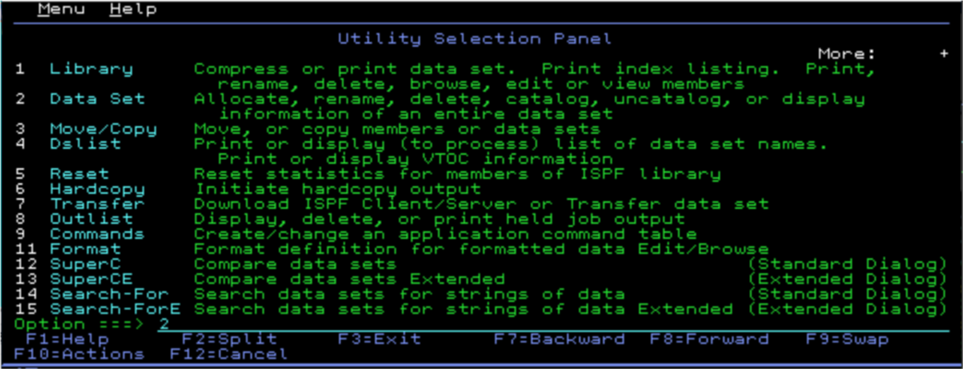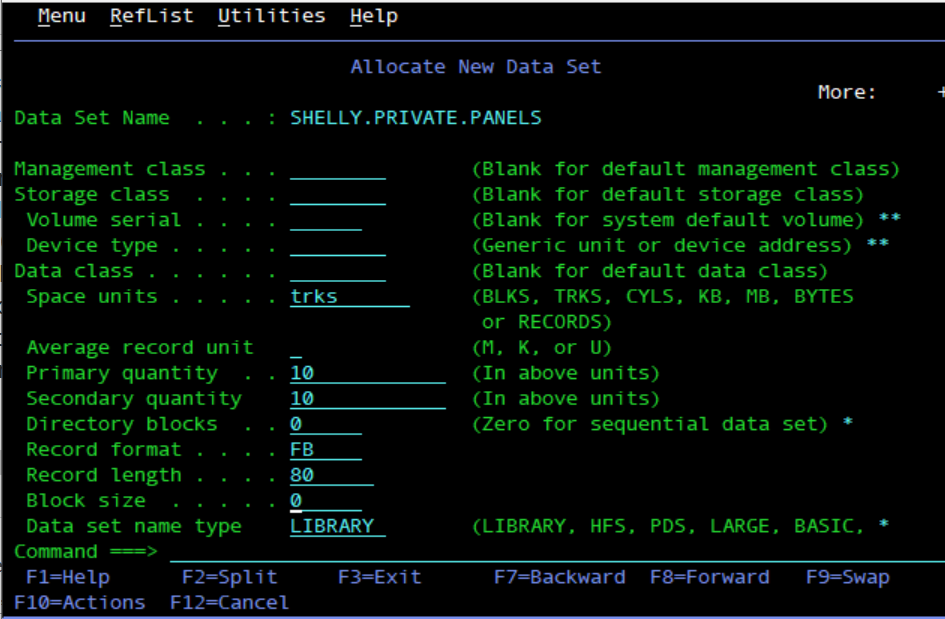Question & Answer
Question
Where are the parts of an application stored? What data sets do I need to write an ISPF application? How do I create the data sets I need?
Answer
On z/OS, files are generally called data sets. There are many different types of data sets, but ISPF mainly uses:
- Sequential data set - a file that is read from start to finish
- Partitioned data set (often called PDS or PDSE) - a file that is partitioned into members, each of which acts as a sequential data set. A partitioned data set groups files together. ISPF makes extensive use of partitioned data sets to store application elements. For example, you can have one PDS to store your panels, and a different one to store your messages. These data sets are called ISPF libraries.
Data sets can be grouped and identified by ddnames (data definition names). ISPF uses the following ddnames to find the application elements:
| DDName | Application Elements |
|---|---|
| ISPPLIB | Panels |
| ISPMLIB | Messages |
| ISPTLIB | Tables |
| ISPTABL | Output tables |
| ISPPROF | Profiles |
| ISPLLIB | Functions written in compiled languages and stored as load modules |
| SYSPROC and SYSEXEC | Interpreted functions written in REXX or CLIST |
Note that ISPF-specific ddnames all start with ISP. Prefixes ISP and ISR are reserved for ISPF use, so do not name your application elements with names that start with ISP or ISR. SYSEXEC and SYSPROC are not specific to ISPF, and can be used to hold REXX execs for any application you want to run, not just ISPF.
ISPF itself is an ISPF application. That is, just as ISPF processes functions, panels, messages, and tables in your application, ISPF processes its own functions, panels, messages, and tables. ISPF is shipped as a set of data sets for each of these types of data.
| Data Set | DDName | Application Elements |
|---|---|---|
| ISP.SISPCLIB | SYSPROC | Command procedure functions written in REXX or CLIST |
| ISP.SISPEXEC | SYSEXEC | Command procedure functions written in REXX |
| ISP.SISPLOAD | ISPLLIB or STEPLIB | Load module functions |
| ISP.SISPLPA | ISPLLIB or Link Pack Area | Load module functions stored in the Link Pack Area |
| ISP.SISPMACS | Macros | |
| ISP.SISPMENU | ISPMLIB | Messages in English |
| ISP.SISPPENU | ISPPLIB | Panels in English |
| ISP.SISPSENU | ISPSLIB | Skeletons in English |
| ISP.SISPTENU | ISPTLIB | Tables, including profiles and command tables, in English |
Creating Application Data Sets
You need to create data sets to hold the parts of your application. The easiest way to create data sets is to use the ISPF Data Set Utility. From the ISPF Primary Options Menu, type 3 in the Options field and press the enter key.


The allocate option creates data sets. Enter A on the command line, and type PRIVATE.PANELS in the Name field. The allocate option creates a data set with the name of prefix.PRIVATE.PANELS to hold your panel definitions. The prefix is your TSO prefix, which is usually your userid, and it is automatically added to the data set name.


Press Enter to complete the allocation and return to the Data Set Utility panel. A short message displays in the top right of the screen. If the allocation was successful, the message says, "Data set allocated." Press the F1 key (which is assigned to the Help command, by default) to see more information in a long message. The long message displays the name of the data set allocated and the volume it was allocated on.
To allocate a library for the Dialog Tag Language parts, which you can use to define the panels, change the name of the data set name to PRIVATE.DTL, and use the A command. The values you used to define the PRIVATE.PANELS library are pre-filled, so press the Enter key to use those values. Allocate data sets named PRIVATE.MSGS for messages and PRIVATE.EXEC for command functions with the same values. If you want to experiment with tables or skeletons, you can also allocate PRIVATE.TABLES for tables, and PRIVATE.SKELS for file tailoring skeletons.
If you want to write compiled functions, you also need to allocate a data set such as PRIVATE.SOURCE or PRIVATE.C to hold the source and PRIVATE.OBJ to hold the compiled output.
Program objects (which are sometimes called load modules) are allocated slightly differently. Allocate a data set called PRIVATE.LOAD. Program objects have unformatted records. You can use the same defaults for most of the fields as the other libraries, but set Record format to U, Record length to 0, and Block size to 6144.

You now have the data sets you need to write an ISPF application.
Was this topic helpful?
Document Information
Modified date:
09 December 2020
UID
ibm16379198